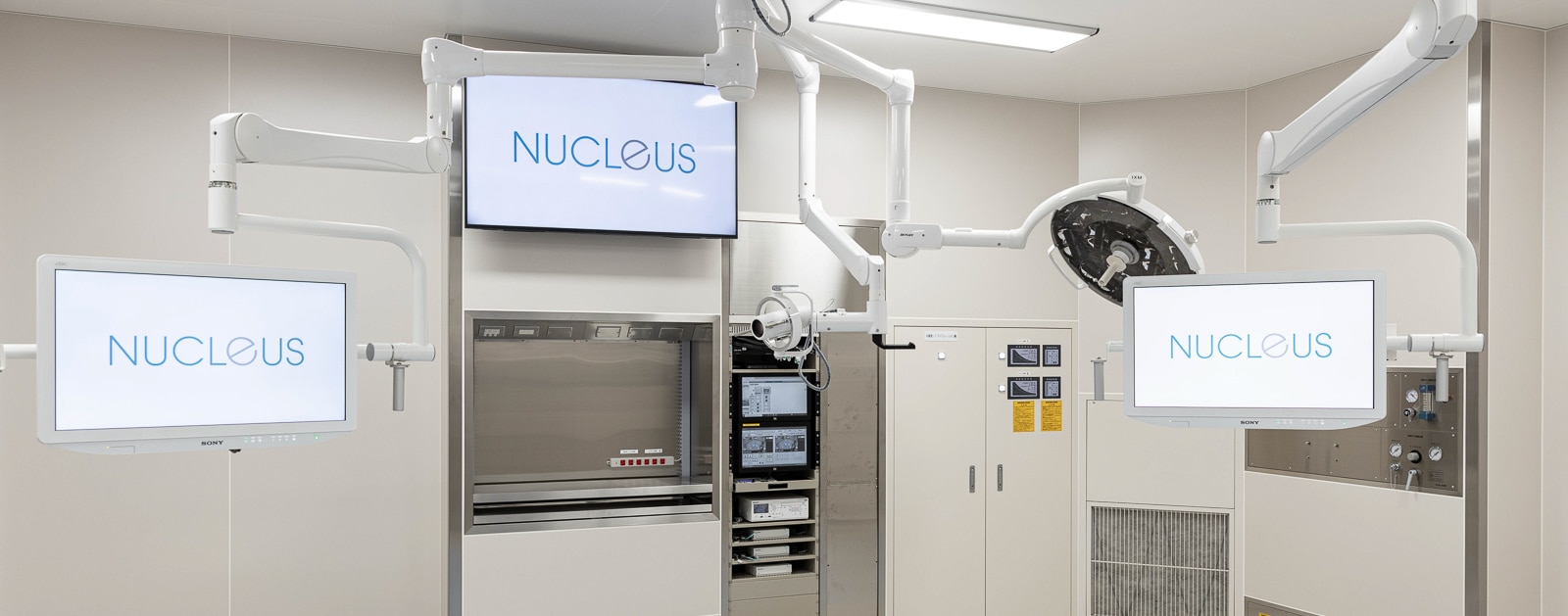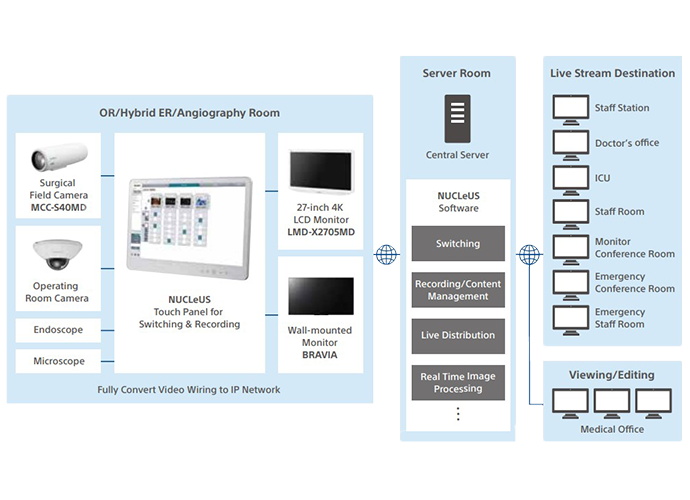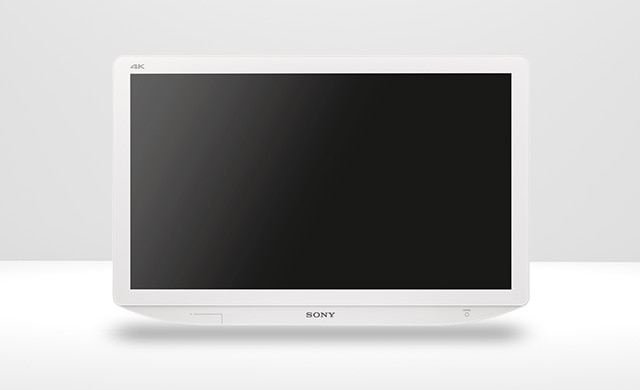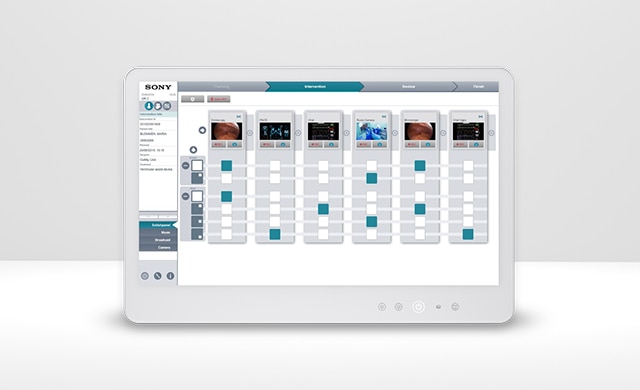
Tokyo Women’s Medical University deploys NUCLeUS smart imaging platform
Adachi Medical Center, a major regional facility for tertiary care at Tokyo Women’s Medical University, has implemented Japan’s largest scale IP-based hospital imaging system*.
- Adachi Medical Center required flexible, easy-to-use IP system for live 4K image sharing over LAN
- Needed system capable of connection with hospital’s medical records system, and supporting secure storage and management of patient data
- NUCLeUS™ IP-based imaging system allows live distribution of video from surgical procedures to screens in OR
- Live and recorded images can also be shared with staff in other areas of the hospital including doctors’ offices
- Staff in OR enjoy clear view of surgical images in 4K resolution on large monitors
- Efficient hospital workflow
- High quality image sharing enhances medical teaching, training and conference presentations
- Secure system protects privacy of patient data
We chose Sony’s NUCLeUS system because it is a technically advanced and highly scalable system that offers straightforward IP-based operation over general-purpose LAN cable, and delivers excellent live 4K imaging.
Hideaki Miyata, Yuriko Kobayashi and Yasuo Tōyama, Information Systems Office, Adachi Medical Center, Tokyo Women’s Medical University
Major tertiary care facility adopts NUCLeUS
A branch of Tokyo Women’s Medical University, Adachi Medical Center is a major regional facility that’s fully equipped for tertiary emergency care. While moving into its newly-constructed site, the Center installed Sony’s NUCLeUS medical imaging platform – representing one of the largest implementations* of an IP-based hospital imaging system in Japan.


Overview of the deployed system
Installing NUCLeUS has enabled centralised management of hospital imaging data over a standard IP network that currently links 12 operating rooms, angiography rooms, and a hybrid ER. The system allows capture of high-quality video of surgical procedures, with images displayed on large monitors that can also be live-streamed to other areas of the hospital. Recorded images are linked with the hospital’s electronic medical records system, and can also be used to support medical conferences and training.
Enhancing medical education and training
Access to high-resolution video of surgical procedures plays an important role in enhancing the quality of medical education and training. Support staff in the OR who previously didn’t enjoy a clear direct view live of surgical procedures can now view 4K images on large wall-mounted and ceiling-suspended monitors. The powerful image processing capabilities of NUCLeUS also add structure and colour enhancement of video footage, resulting in exceptionally clear, precise images that can contribute significantly to training.
Switching images at a touch
NUCLeUS features intuitive touch panels with a user-friendly GUI interface that allows smooth switching of displayed images in real time.
A further benefit of installing NUCLeUS is the system’s link to the OR’s anesthesia logging system, ensuring that recording always starts when an operation begins. And since the platform is based on standard IP communications, there’s no time wasted hunting for compatible video cables supporting multiple image standards. All that’s required to interconnect equipment is plugging in widely-available, easily replaceable LAN cables – no specialist IT expertise is required.
Making hospital workflow more efficient
NUCLeUS also streams live video of surgical procedures to dedicated monitors outside the OR, allowing staff in other areas of the hospital to follow the progress of an operation. “In our previous facility, everyone had to use hospital phone lines to stay informed, or else actually walk over to the OR” explains the Information Systems Office team. “The new platform eliminates all of this extra work and stress. It is now much easier for everyone to make necessary preparations before and during the procedure.”
And since NUCLeUS connects with the hospital’s electronic medical records system, OR images can be viewed on any medical records terminal equipped with a nearby monitor or projector. Recorded images can be accessed from doctors’ offices, conference rooms, outpatient facilities and other areas of the hospital.
The system allows the Hospital administrative authorisation to set-up secured protocols for access required before video data can be used at medical conferences or similar settings. Image data can be saved to dedicated, password-protected media, accessible only from dedicated terminals and predetermined locations.
“After several months of use, we have not only seen how the system supports conferences and presentations, but we have also heard reports from staff about how it enhances medical workflow” the team confirms.
Download and read Adachi Medical Center’s full case study
Looking to the future
The NUCLeUS system installed at Adachi Medical Center currently includes various Sony components including MCC-S40MD** medical cameras, LMD-X2705 monitors and HVO-3300MT video recorders.
The facility currently operates its own dedicated server room, where over 100 TB of data is stored on premises. The team is already anticipating the benefits of switching to cloud-hosted storage, as well as live video streaming to external sites: “Saving this data to the cloud would probably be a better approach from a business continuity standpoint. Last, but not least, we would like to use the system to support remote medical care, by enabling live streaming over authorised mobile devices to and from related hospitals and other outside sites. We are confident that Sony’s expertise in leading-edge imaging and broadcasting technologies can bring great benefits to the medical arena.”
* Based on Sony research, as of 29 March 2022.
** Availability will depend on region.





